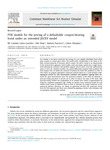PDE Models for the Pricing of a Defaultable Coupon-Bearing Bond Under an Extended JDCEV Model

Use este enlace para citar
http://hdl.handle.net/2183/28311
Excepto si se señala otra cosa, la licencia del ítem se describe como Atribución-NoComercial-SinDerivadas 4.0 Internacional
Colecciones
- Investigación (FIC) [1705]
Metadatos
Mostrar el registro completo del ítemTítulo
PDE Models for the Pricing of a Defaultable Coupon-Bearing Bond Under an Extended JDCEV ModelFecha
2021Cita bibliográfica
CALVO-GARRIDO, M. Carmen, et al. PDE models for the pricing of a defaultable coupon-bearing bond under an extended JDCEV model. Communications in Nonlinear Science and Numerical Simulation, 2021, p. 105914.
Resumen
[Abstract] We consider a two-factor model for the pricing of a non callable defaultable bond which pays coupons at certain given dates. The model under consideration is the Jump to Default Constant Elasticity of Variance (JDCEV) model. The JDCEV model is an improvement of the reduced form approach, which unifies credit and equity models into a single framework allowing for stochastic and possible negative interest rates. From the mathematical point of view, the valuation involves two partial differential equation (PDE) problems for each coupon. First, we obtain the existence of solution for these PDE problems. In order to solve them, we propose appropriate numerical schemes based on a Crank-Nicolson semi-Lagrangian method for time discretization combined with quadratic Lagrange finite elements for space discretization. Once the numerical solutions of the PDEs are obtained, a post-processing procedure is carried out in order to achieve the value of the bond. This post-processing includes the computation of an integral term which is approximated by using the composite trapezoidal rule. Finally, we present some numerical results for real market bonds issued by different firms in order to illustrate the proper behaviour of the numerical schemes. Moreover, we obtain an agreement between the numerical results from the PDE approach and those ones obtained by applying a Monte Carlo technique and an asymptotic aproximation method.
Palabras clave
Defaultable coupon bond
JDCEV pricing model
PDE formulation
Semi-Lagrangian method
Quadratic Lagrange finite elements
JDCEV pricing model
PDE formulation
Semi-Lagrangian method
Quadratic Lagrange finite elements
Descripción
Financiado para publicación en acceso aberto: Universidade da Coruña/CISUG
Versión del editor
Derechos
Atribución-NoComercial-SinDerivadas 4.0 Internacional






